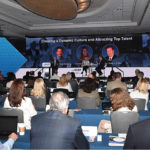The event technology showcased at MTE 2013 — held at the Holiday Inn Midtown in New York City on Sept. 17 — included everything from apps that connect you with likeminded people nearby based on your GPS coordinates, to digital platforms allowing you to create your own custom event app step by step, without having to invest thousands of dollars. I was there on behalf of Convene, attending in-depth sessions on meetings and attendee management and discovering the latest products in the event-tech sphere.
Eric Ly, co-founder of LinkedIn and founder of Presdo, an event app designed to facilitate better networking, spoke at the opening general session. To a room of more than 100 event professionals, Ly explained how LinkedIn performs a function similar to any live event, by creating a global community within a brand. When looking to create their own communities, he advised MTE attendees to make and use products that are simple and accessible, and easy to use for a wide range of generations. Aware of his budget-conscious audience, Ly encouraged the group not to focus too much on the bottom line when first trying out new technologies. “Monetization comes after you have an engaged community,” Ly said.
Many of the sessions at MTE were dedicated to creating just that: an engaged community. “Allow attendees to influence the conversation,” Event Farm’s Brennan McReynolds said during a session about new developments in attendee management. You can create a strong community around your meeting’s content, McReynolds said, by soliciting suggestions and feedback from attendees, sharing openly and often with your audience, providing peer-to-peer teaching moments, and featuring attendee-curated content. “If we don’t listen to our audience,” McReynolds said, “they’re going to go talk somewhere else.”
Games are another good way to engage delegates, Quick-Mobile’s Trevor Roald said during a session on gamification. By rewarding attendees, you are giving them goals and motivating them to interact not just with the technology but with each other. “Think carrot, not stick,” Roald said about creating rewards that encourage participation. He noted that smaller prizes motivate engagement more than large prizes because everyone feels they have a better shot at winning. It’s important to build the rules and goals of a game around attendees’ wants and needs — and even more important to make the game fun. “Keep it simple and fair,” Roald said. “Don’t force them to do it. That’s no fun.”
On the show floor, which this year featured 33 exhibitors, it was evident that meeting-technology companies are working hard to engage attendees by creating innovative products that put planners in the driver’s seat. Many of the apps and platforms showcased at MTE — like Attendify, a custom-app-building platform, and Guidebook, a social and mobile platform that helps attendees explore meeting destinations — are low-cost, easy-to-use, and give event professionals the autonomy to construct their meetings the way they want.
During the final session I attended, dedicated to crowd -sourcing, Simon Bryan, managing director of Lumi Technologies, an event-strategy company, discussed the importance of reaching out to your audience and curating content that matters to them. “Technology is a tool to uncover insights,” Bryan said. “Don’t chase technology, chase insights.” For organizers to understand their audience, it’s crucial that they get as close to attendees as possible, without a lot of complicated, expensive technology getting in the way. Now is the time of lightweight, accessible technology that organizer and attendee alike can understand and engage with. “Attendees are crying out to be engaged,” Bryan said. “They want to be empowered.”



